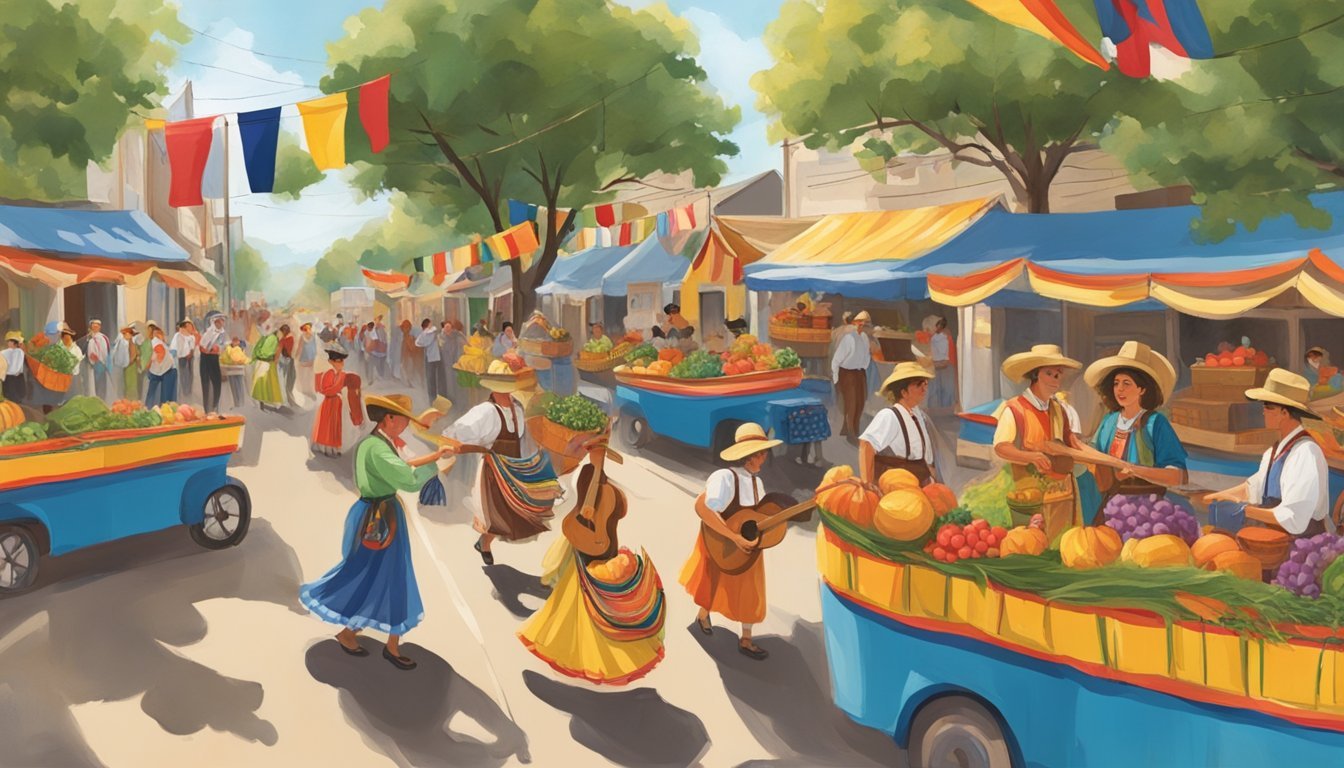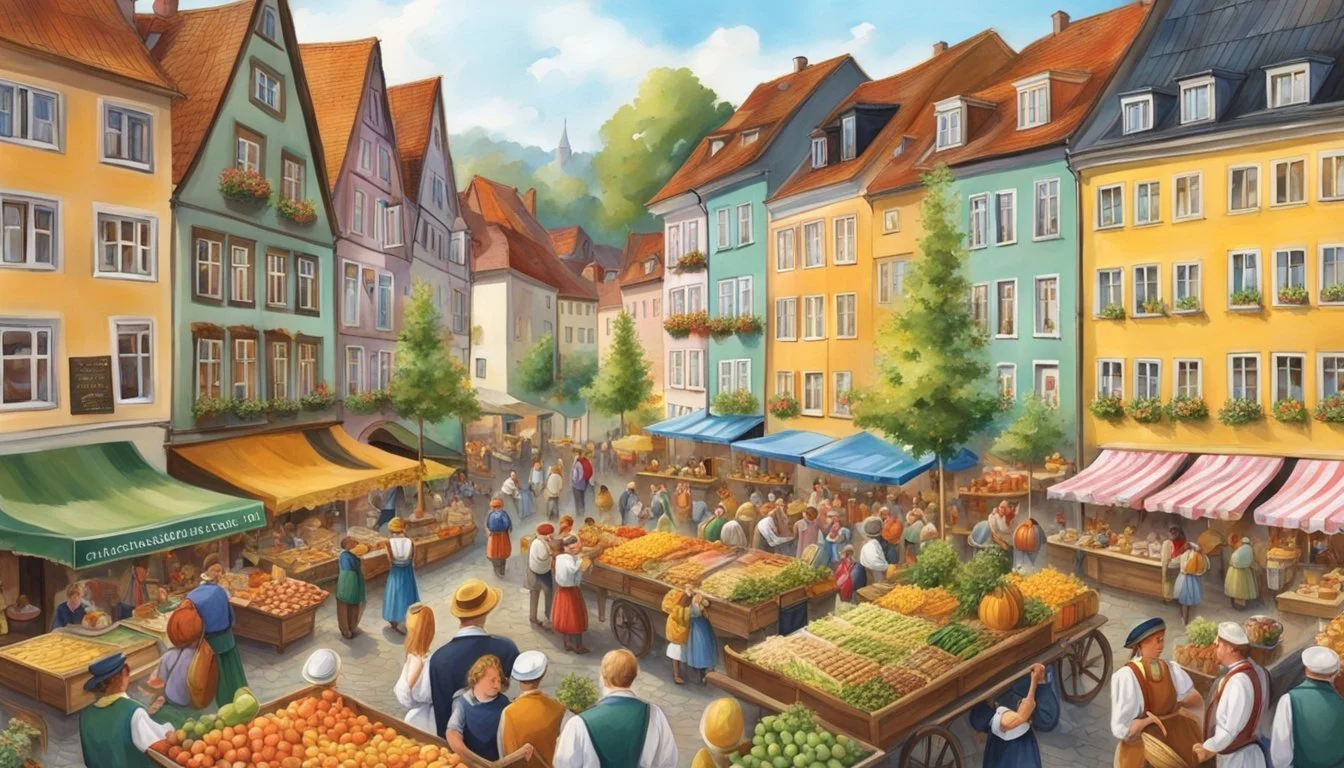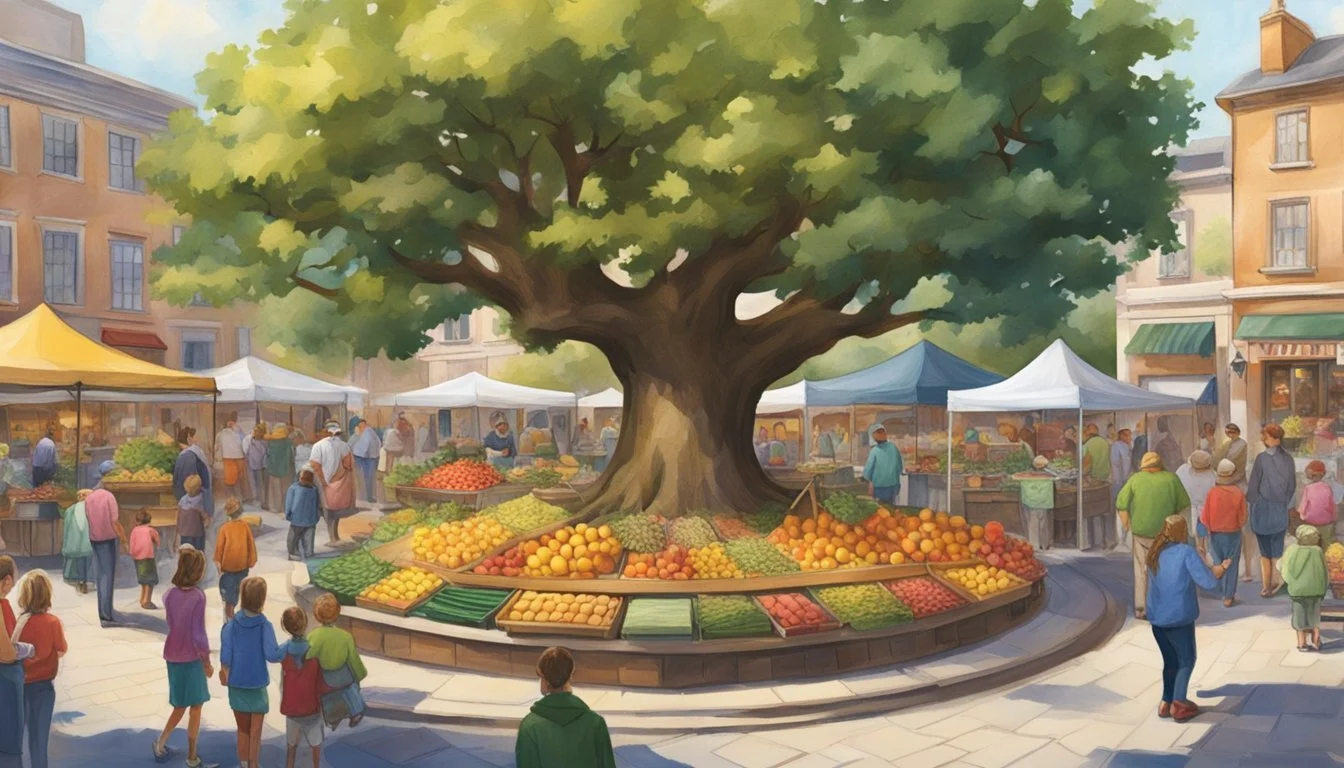German Texan Traditions for Erntedankfest
Celebrating the Harvest Festival with Authentic Flair
In Texas, the fusion of German and Texan traditions has cultivated a distinctive celebration of Erntedankfest, the German equivalent of the Harvest Festival. This cultural hybrid stands as a testament to the German immigrants who settled in Texas during the 19th century, bringing with them their customs, which have since been interwoven with Texan culture. The Erntedankfest in German Texan communities is an autumnal event that not only reflects gratitude for the year's harvest but also reinforces the strong ties to their German heritage.
The festival is marked by a cornucopia of activities that blend the old and the new. Traditional German music, dance, and attire can be seen alongside Texan hospitality and cuisine. Faith plays a central role in the celebration with church services giving thanks for the harvest, a core aspect of Erntedankfest. The festivities also often feature parades and the presentation of a "harvest crown," honoring the bounty brought forth from the fields.
German Texan Erntedankfest celebrations encapsulate the spirit of community and gratitude, characteristics that are hallmarks of harvest festivals worldwide. Local farmers are honored, and communities come together to share the fruits of their labor, both literal and metaphorical. These traditions have been preserved and adapted over generations, ensuring the continuation of a unique cultural legacy in the heart of Texas.
Historical Origins of Erntedankfest
Erntedankfest, directly translated as "harvest thanksgiving festival", is deeply rooted in Germany's agricultural history. It is a traditional celebration that stems from the country's gratitude towards a bountiful harvest. The origins of Erntedankfest can be traced back to pagan times when rituals were performed to appease the deities of crops and fertility.
As Christianity spread throughout Europe, these pagan customs were assimilated into the Christian calendar. The religious aspect of the holiday intensified, with the church integrating thanksgiving into its liturgy. Erntedankfest emerged as a formal religious holiday, primarily observed by the Protestant and Catholic churches. Unlike the first Thanksgiving in Plymouth, Erntedankfest was not a singular historical event but rather evolved as an annual tradition.
It is a celebration that typically takes place in September or October, varying by region, which aligns with the end of the harvest season. German communities, both rural and urban, spend the day giving thanks for the year's yield. This festival is marked by church services that include sermons and choir singing overflowed with themes of gratitude and provisions.
Throughout its history, Erntedankfest has remained a symbolic observance, with its core lying in giving thanks for nature's bounty. It reflects a convergence of ancient harvest traditions and religious practices, embodying a heritage that remains a significant cultural touchstone in Germany to this day.
German Texan Erntedankfest Celebrations
German Texan Erntedankfest celebrations blend traditional German harvest festivities with local Texan influences. These celebrations are marked by a rich tapestry of religious observances, festive activities, indulgence in culinary traditions, and a lineup of cultural performances.
Religious Observances
German Texan communities hold special church services on Erntedankfest to express gratitude to God for a successful harvest. These services often include the decoration of the altar with a wreath of flowers, grains, and fruits symbolizing the bounty of the harvest. The congregation participates in prayer and song, usually led by a church choir, to give thanks for the blessings of the year.
Festive Activities
Erntedankfest is also a time for communal joy. The festival features a Thanksgiving procession where participants may carry a traditional harvest crown, and sometimes, select a harvest queen or "Erntekönigin". Children often engage in a lantern and torch parade ("Laternenumzug"), carrying handmade lanterns through the streets as evening falls.
Culinary Traditions
Food is central to Erntedankfest celebrations. Tables are laden with a spread of traditional German foods and drink, emphasizing hearty fare made from local produce. Recipes passed down through generations get a Texan twist, incorporating regional ingredients like pecans and peppers. Customary dishes include roast meats, stews, freshly baked breads, and fat-rich desserts.
Cultural Performances
German Texan Erntedankfest provides a stage for showcasing a variety of cultural performances. Folk music and dancing are performed while wearing traditional German attire, celebrating both the heritage of the German settlers and the vibrant culture they have fostered in Texas. These performances often culminate in community singing and dancing, reinforcing the shared bond of the celebrants.
Integration of Erntedankfest with American Traditions
German Texans have found a harmonious balance between the traditional Erntedankfest and the American Thanksgiving. These communities often celebrate Erntedankfest on the first Sunday in October, reflecting its typical observance in Germany. In contrast, America's national holiday dedicated to giving thanks takes place on the fourth Thursday of November.
Table: Key Differences and Integrations
German Erntedankfest American Thanksgiving Integration in German Texan Culture Religious in nature Family-centric and national Combines church services with family gatherings Wheat, corn, and flowers Turkey and pumpkin Decorations often include both German and American symbols Non-commercial Wider national celebration with parades Modest community festivals Sermons and religious reflection Football games and music Inclusion of religious services followed by communal activities
German Texans typically host a feast that includes both traditional American dishes such as turkey and pumpkin pie, as well as German delicacies. The fusion creates a celebration that honors both heritages. Rural traditions are finely woven into the festivities through the display of bountiful harvests including items like wheat sheaves, corn, and flowers, which add to the atmosphere of thanksgiving.
Religious services, often held in Protestant or Catholic churches, integrate American Christian hymns with German liturgy and sermons. They reflect the deep-seated religious aspect of the holiday that is important for both cultures. Community gatherings may also feature German music, providing a soundtrack that marries the new world with old traditions.
In this way, German Texans pay homage to their roots while embracing their American identity, illustrating the unique blend of Erntedankfest with American traditions.
Significance of Harvest in Agriculture
Harvest has long stood at the heart of agricultural communities, symbolizing the culmination of a season's labor and the success of cultivating crops. It is a critical period for farmers, as the harvest determines the yield of grains, fruit, and other produce, essentially sustaining the community's economic and food supply.
The process of gathering fully ripened crops is instrumental for farmers who depend on the success of their harvest for their livelihood. Nowadays, tractors and modern machinery have streamlined the harvesting process, allowing for a more efficient collection of crops.
Historically, harvest festivals, such as Erntedankfest, have offered a moment to express gratitude for the year's bounty. Celebrations often include crowning a harvest queen, signifying honor and hope. While the first thanksgiving is often associated with the Pilgrims and Wampanoag tribe in New England, harvest festivities have deeper, global roots. In Germany, particularly among German Texan communities, these traditions intertwine with the local culture, enriching the sense of community and shared success.
Wine, derived from harvested grapes, frequently features in these festivities, serving both as a product of agriculture and a symbol of the fruitfulness of the land. These festivals not only acknowledge the fruits of this year's labor, but also inspire hope for next year's cycle of planting, tending, and harvesting.
In sum, harvest is not merely the action of reaping crops but also a keystone of agricultural practice, economic stability, and cultural heritage that warrants celebration and respect.
Community and Family Roles in Erntedankfest
In the rich tapestry of German Texan heritage, Erntedankfest plays a significant role, embodying unity, tradition, and celebration. Families come together to foster a sense of continuity, honoring their European roots while intertwining them with the fabric of American life. The festival is a time when community and family interconnect with shared responsibilities and expressing gratitude for the harvest.
Community Involvement
Church Services: Local churches organize special services, integrating sermons and choral singing that highlight the theme of thanksgiving and blessings of the rural harvest.
Parades and Festivities: Communities often arrange parades featuring music, which children and adults alike participate in, showcasing the communal spirit.
Family Contributions
Feasting: The centerpiece of family celebration is the feast, where households prepare traditional dishes that blend German and Texan flavors. It demonstrates the merging of two cultures in the American setting.
Passing Down Traditions:
Cooking: Recipes are passed down, with both adults and children involved in the cooking process.
Crafts: Families may create harvest crowns as part of the festivities, with children learning from their elders.
Home Decor: Homes are adorned with seasonal decorations to create a festive atmosphere.
Erntedankfest in the German Texan communities exemplifies a blending and preservation of cultural identity within the broader American Thanksgiving framework. It is an occasion for reaffirming family ties and celebrating the cultural mosaic that is America. Through these shared experiences, the essences of family, feast, and festivity are elevated, strengthening the bonds of heritage and unity.
Future of German Texan Erntedankfest Traditions
The future of Erntedankfest traditions within the German Texan community is a fusion of maintaining heritage while adapting to contemporary cultural landscapes. They continue to honor their rural roots by celebrating the end of harvest, but with a nod to progress and a diverse, expanding North America.
Tradition: The celebrations will likely preserve practices such as church services and communal meals, central to the expression of gratitude for the harvest.
Adaptation: Events may evolve, integrating local Texan customs with traditional German elements, ensuring relevance to younger generations.
In rural German Texan areas, these harvest festivals are crucial in strengthening community bonds. The emphasis on local tradition emphasizes the unique German Texan identity.
Heritage: Educational components about German Texan history may become more prominent, highlighting the significance of Erntedankfest.
Culture: Incorporating music, dance, and food from both German and Texan cultures is anticipated to continue, enriching the experience.
For future generations, these cultural intersections promise to keep their heritage vibrant. The adaptability of Erntedankfest traditions serves not only as a means for cultural expression but also as a marker of the German Texan community's resilience.
Progress: Leveraging technology, social media can play a role in promoting festivities and fostering wider participation.
Looking forward, one anticipates an enduring, dynamically evolving Erntedankfest, where tradition meets innovation, preserving the past, and celebrating the future.
Similar Festivals and Observances Worldwide
Harvest festivals are a global phenomenon, with each country bringing its own traditions and rituals to the celebration. In Germany, Erntedankfest is observed with religious services and communal feasting, reflecting on autumnal plenty. The festival, typically taking place in late September or early October, is similar to Thanksgiving but remains distinctly rooted in German customs.
In North America, both Canada and the United States celebrate Thanksgiving. The Canadian holiday occurs on the second Monday of October, while the American Thanksgiving is celebrated on the fourth Thursday of November. This festivity, steeped in the tradition of giving thanks for the harvest, has become a national holiday characterized by parades, family gatherings, and large meals featuring turkey and seasonal produce.
European countries each have their own versions of harvest festivals. In the United Kingdom, for example, Harvest Festival is an annual celebration that occurs around the same time as the American and Canadian Thanksgiving, involving church services and decorating with homegrown produce.
Oktoberfest, though notably a beer festival, originally started as a celebration of the year's harvest and is now a global event synonymous with German culture, especially in German-Texan communities.
Country Festival Dates Features Germany Erntedankfest Late September or early October Religious services, processions United States Thanksgiving Fourth Thursday of November Parades, family gatherings, turkey meals Canada Thanksgiving Second Monday of October Family gatherings, harvest meals UK Harvest Festival Around September/October Church services, produce decorations
Harvest celebrations often reflect the values of unity and thankfulness. These festivals serve to not only honor the bounty of the land but also to reinforce community bonds as seasons change.
Conclusion
Erntedankfest, the German version of Thanksgiving, represents a significant tradition among German Texans, embodying a spirit of gratitude and community celebration. In Texas, where many Germans settled, they maintained this celebration, intertwining it with the local customs and agricultural calendar. Thus, Erntedankfest has become a meaningful occasion for German Texans to honor their cultural heritage and the bounty of the harvest.
Traditions have always been the cornerstone of Erntedankfest. Incorporating church services, processions, and the presentation of the harvest crown, these customs preserve the religious and cultural history of the festival. Moreover, the focus on community involvement reflects a shared pride and unity within the German Texan communities, continuing to strengthen bonds across generations.
The celebration of the harvest is a joyful expression of thankfulness for the year's yield, expressed through communal feasts, decorations with cornucopias, and the sharing of food—a practice deeply rooted in the German traditions that early immigrants brought with them to Texas.
German Texans remain dedicated to honoring their heritage through Erntedankfest. The festival transcends mere historical observance; it is a vibrant, living tradition that adapts with time while still retaining its original sentiments of thankfulness and recognition of the land's generosity.
In summary, Erntedankfest among German Texans exemplifies an annual cultural event that cherishes agricultural achievement, expresses gratitude for the harvest, and promotes community cohesiveness, all while celebrating the enduring German Texan heritage.










